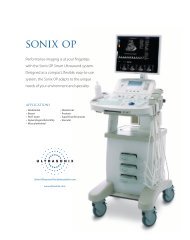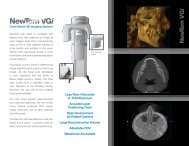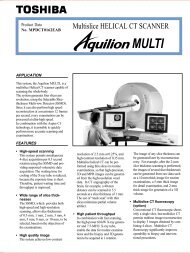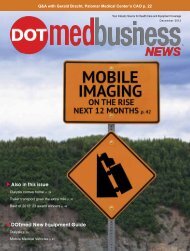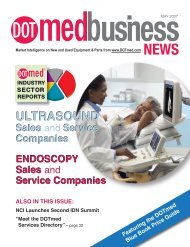I S S U E - DOTmed.com
I S S U E - DOTmed.com
I S S U E - DOTmed.com
Create successful ePaper yourself
Turn your PDF publications into a flip-book with our unique Google optimized e-Paper software.
Many manufacturers<br />
and end users of MRIs<br />
have been on a conveyer<br />
belt of reduced<br />
profitability for a few<br />
years now as a result of the Deficit Reduction<br />
Act (DRA) and ongoing economic<br />
instability. National MRI sales have plummeted<br />
this year and more reimbursement<br />
cuts could be in store, keeping widespread<br />
capital budgets on ice, but not all is doom<br />
and gloom. MRI is still a leading source<br />
of revenue in hospitals and imaging centers<br />
across the country, advanced 3T systems<br />
and niche technologies like open<br />
and upright MRI scanners are continuing<br />
to sell and the independent service business<br />
is holding strong. Growing trends<br />
like non-contrast imaging, MR scanning<br />
for dementia, and intraoperative and interventional<br />
MRI are emerging applications<br />
worth getting excited about.<br />
Stark statistics for<br />
manufacturers<br />
NEMA, the association for electrical<br />
and medical imaging manufacturers,<br />
reports periodic sales statistics to its<br />
members. The association reported that<br />
the MRI market as a whole declined by<br />
9% last year, says Joel Urick, MR product<br />
manager for Toshiba.<br />
That statistic is mild <strong>com</strong>pared to<br />
year-to-date market numbers. NEMA<br />
reported that through the second quarter<br />
2009, the overall MRI market was down<br />
40%, says Stephen Mitchell, senior director<br />
of Philips’ MR Imaging Systems.<br />
“The biggest factor has been the<br />
economic crash of late 2008,” says<br />
Mitchell. “That has basically put a lot of<br />
imaging projects on hold.”<br />
“In 2003, MRI sales were approaching<br />
1,200 units a year,” says Hitachi Medical<br />
Systems’ vice president and general<br />
manager of MR and CT, Sheldon Schaffer.<br />
“In 2009, the best estimate in annual<br />
sales from a unit volume perspective will<br />
probably be around 700 MRI units. There<br />
has been a significant decline.”<br />
In addition to the economy, the<br />
DRA’s impact on the imaging industry<br />
has been far and wide, but the freestanding<br />
MRI industry has been hit especially<br />
hard. The intent of the DRA imaging cuts<br />
were to slow the rapid growth of Centers<br />
for Medicare and Medicaid (CMS) bill-<br />
ing for imaging services <strong>com</strong>ing from<br />
practicing physicians and freestanding<br />
imaging in the early 2000s.<br />
“You saw a great increase in billing<br />
in the years 2000 to 2006,” says Cynthia<br />
Moran, assistant executive director<br />
for the American College of Radiology<br />
(ACR) Government Relations and Economic<br />
Policy Department. “Imaging<br />
services were the fastest growing <strong>com</strong>ponent<br />
of Medicare spending at that<br />
time, but since the DRA, this growth<br />
rate has flattened out.”<br />
The DRA led to cuts in the Medicare<br />
Physician Fee Schedule (MPFS)<br />
and Hospital Outpatient Prospective<br />
Payment System (HOPPS), which had<br />
the effect of slashing reimbursement for<br />
MRI procedures anywhere from 20% to<br />
30%, and perhaps even 40%, some analysts<br />
say. “That is not an unreasonable<br />
estimate,” says Moran.<br />
The Medicare Payment Advisory<br />
Commission (MedPAC) has now advised<br />
CMS to increase the imaging<br />
industry’s utilization rate from 50% to<br />
90%. If passed, the new relative value<br />
formula would effectively act as an additional<br />
cut in reimbursement, but some<br />
think that this modality may be spared,<br />
because “the DRA has already taken<br />
such a bite out of MRI,” says Moran.<br />
Established in 1981, the Center for<br />
Diagnostic Imaging (CDI) was one of the<br />
first freestanding imaging centers in the<br />
country and is now a network of providers<br />
practicing in 50 imaging centers nationwide.<br />
CEO, Bob Baumgartner, says<br />
that MRI is still the primary revenue provider<br />
for the network. Not only have the<br />
economy and reimbursement cuts had an<br />
impact, but the credit crisis has affected<br />
the viability of the MRI industry.<br />
“The credit crisis has made it difficult<br />
for imaging providers to sell their<br />
practices or finance acquisitions,” says<br />
Baumgartner. From the patient perspective,<br />
Baumgartner is also seeing higher<br />
deductible co-pays and more patients<br />
delaying services, especially for discretionary<br />
musculoskeletal imaging, such as<br />
MRI scans for generalized back pain.<br />
Optimism prevails for some<br />
hospitals<br />
Clinical Radiologists, S.C., is a large radiology<br />
group headquartered in Spring-<br />
field, Ill. Dr. Craig Russo is vice chairman<br />
of radiology at Memorial Medical<br />
Center, the largest hospital within the<br />
group, which includes more than 50 radiologists<br />
and operates in 20 hospitals and<br />
over 30 outpatient and stand-alone clinics<br />
throughout the Midwest. The group<br />
interprets exams from over 30 MRI scanners,<br />
with the majority of them being GE<br />
and Siemens 1.5T systems.<br />
Unlike some other <strong>com</strong>munities,<br />
Springfield has a thriving medical <strong>com</strong>munity<br />
and the economic downturn<br />
and threat of health care reform have<br />
not dampened their technological investment.<br />
“The hospitals here have<br />
been investing quite vigorously in MRI<br />
lately,” says Dr. Russo. “This is a fairly<br />
small <strong>com</strong>munity, maybe about 120,000<br />
people - and in the last year we’ve gone<br />
from one 3T magnet to three…This hospital<br />
and this administration in particular,<br />
have looked at it from the standpoint<br />
that now is the time to make the investment<br />
in order to be very well equipped<br />
in the near term as well as long-term.”<br />
One service location recently invested<br />
in the Siemens MAGNETOM Verio<br />
3T. “Clearly, the patient experiences less<br />
claustrophobia and technologically, it’s a<br />
very advanced system,” says Dr. Russo.<br />
“We don’t have to make any sacrifices in<br />
terms of image quality.”<br />
Fonar Upright ® Multi-Position MRI<br />
<strong>DOTmed</strong>business news I s e p t e m b e r 2009 21




